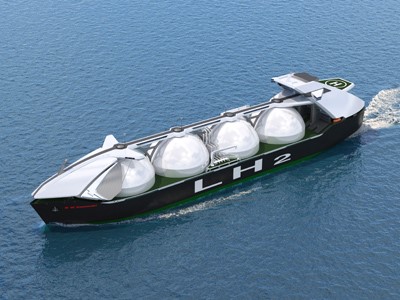News
Kawasaki receives AiP for large-scale containment system for LH2 carrier

Kawasaki Heavy Industries, Ltd. has obtained AiP from Nippon Kaiji Kyokai (ClassNK) for a cargo containment system offering the world's largest capacity (40,000 m3 class per tank), developed for use on a large liquefied hydrogen carrier.
The cargo containment system for which the AiP was obtained is designed to contain cryogenic liquefied hydrogen, reduced to a temperature of –253°C and one eight-hundredth its initial volume, for shipping by sea in large amounts. This containment system has the largest capacity of its kind worldwide used in liquefied hydrogen marine transport. The cargo containment system was developed using design, construction and safety technologies fostered through building of the SUISO FRONTIER,*1 a pioneering liquefied hydrogen carrier built by Kawasaki that boasts a 1,250 m3 carrying capacity. In addition, the cargo containment system utilizes a new type of insulation structure.
The recently obtained AiP was issued by ClassNK following examinations to confirm that the cargo containment system satisfies the IGC Code*2 and the International Maritime Organization (IMO) Interim Recommendations for Carriage of Liquefied Hydrogen in Bulk,*3 and also clears class regulations as well as a risk assessment based on Hazard Identification Study (HAZID)*4 methods.
The main features of the cargo containment system are as follows.
- Enables transportation of cryogenic liquefied hydrogen in large amounts thanks to tank capacity on par with tanks used on large liquefied natural gas (LNG) carriers
- Utilizes an independent, self-supporting design with a structure capable of responding flexibly to thermal contraction that occurs when loading cryogenic liquefied hydrogen
- Features a newly developed, high-performance heat insulation system that mitigates boil-off gas (BOG) which occurs in response to heat ingress
- Designed to effectively utilize BOG as fuel to power the ship, thus contributing to reduced CO2 emissions from liquefied hydrogen transport operations
Kawasaki developed the cargo containment system as part of a project with financial support from NEDO,*5 and the company is currently developing a large, 160,000 m3 liquefied hydrogen carrier using four cargo containment system tanks, which is scheduled to start commercial operations by the middle of the 2020s. Amid global calls for the early achievement of carbon neutrality targets, Kawasaki is striving to achieve large-volume transport of liquefied hydrogen—for which demand is expected to grow as a clean energy source—in order to promote the use of hydrogen energy and help achieve decarbonization, working as one for the good of the planet.

